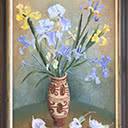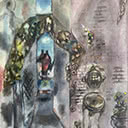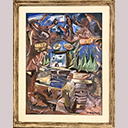Pergola, c. 1936
72.3 x 53.3 cm
est. $100,000 - 200,000
PROVENANCE Collection of the late Anthony Tuer Shawcross Purchased from Alex Reid & Lefevre, (The Lefevre Galleries), Original Lefevre Galleries label affixed verso
EXHIBITED
New Paintings and Watercolours, The Lefevre Galleries, 1937
To be included in The Complete Frances Hodgkins catalogue raisonne
Pergola was exhibited in New Paintings and Watercolours by Frances Hodgkins at the Lefevre Galleries between October and November in 1937, alongside Side Entrance, c. 1932. A complex composition, it is derived from the highly productive time Hodgkins spent at Tossa de mar on the Costa Brava (Wild Coast) in northern Spain from mid- September 1935 to early summer 1936. There was a strong Parisian presence among the summer guests, who loved the sparkling blue sea and brilliant skies, Marc Chagall christening it a 'Blue Paradise' while Dora Maar photographed her intellectual friends perched on the edge of brightly painted fishing boats pulled up on the shore. Once the autumn winds started to blow, most preferred to return to home. But Hodgkins was made of sterner material, the more isolated months giving her the quiet she needed to focus on her compositions without too much interruption. The sweeping curve of the main bay, La Pauma (La Palma), lies spread out below pine-covered hills that rise above the village, marked at one end by the castellated ruins of Vila Vella, the sole remaining medieval fortification on the Catalan coast. When she wasn't recording its imposing structure, Hodgkins preferred the isolation at the opposite end of the bay, not least when the river, which dried up in the summer months, burst forth once temperatures cooled. Its flow was vital for irrigating the patchwork of fields that provided much of Tossa's food supply. Hodgkins was drawn, not to the flat rows of vegetables, but rather the infrastructure that supported their growth. Her time in Tossa de mar was extremely productive for Hodgkins, inspiring at least a dozen of the major paintings included in the Lefevre exhibition the following year. Pergola is a delight to study, as its location has been unknown until recently. Its subject matter, however, making witty references to several major works from the 1930s, each painting more refined than the last. Hodgkins first introduced the pergola motif into watercolours painted in St Tropez in 1931, producing an internal floral frame for a local woman washing garments at an outdoor sink., while in several English watercolours in the intervening years, including Side Entrance, it draws the eye through to the view beyond. In Pergola the title is given to a heavily pruned tree on the left-hand side, its arch of truncated branches framing a lone white building. You can always tell when Hodgkins feels on top of her game, for the house takes on an anthropomorphic quality, its unevenly placed windows serving as eyes that gaze quizzically back at us. Floating around but not attached to the pergola are vegetal forms suggestive of seeds, gourds, and marrows, interspersed by white curlicues that rise like wisps of smoke that appear to be 'embroidered' on the surface. Patches of 'blanket stitch' on the pruned branches heighten this effect. The river itself flows under the bridge in front of the house before being briefly captured in the lavadero in the foreground, where fishermen's wives gathered daily, scrubbing their washing on the flat tops of the broad stone walls. While Hodgkins has consciously avoided the introduction of such figures into her Tossa paintings, her letters of the time attest to the women's presence. [https://completefranceshodgkins.com/ objects/29967/letter-from-frances-hodgkins-todorothy- selby] A water barrel on the right, which would have been filled by hand to aid the villagers' endeavours, stands guard on the right of the wall, while the water, having served its purpose, then gushed beneath the walls before spreading its largesse over the expanse of the beach before reaching the sea. Buildings and walls allowed Hodgkins to introduce reminiscences of Cubist forms, this treatment possibly influenced by the 'Parisian' element of Tossa's summer population. Either side, looking like Indian wigwams, are paller or haystacks, the hay being packed around a central tripod of bamboo. They can be seen in several Tossa paintings, including Spanish Landscape with Stooks in Grey and Pink and Spanish Landscape in Orange, Brown and Green, although in the latter they are to be clad in their freshly cut mantle. Beautifully constructed, its sombre palette of browns and greens lifted by sparkling blues and whites reflective of the local marine environment, Pergola is a masterpiece.
MARY KISLER





